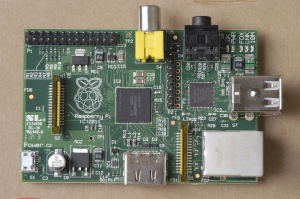
It’s a piece of kit that now sits at the heart of my digital home where I trust it to control the important parts of my online activity.
This wasn’t always the case though. In fact, it took me quite a while to realise just how good this board actually is.
Set the wayback machine for Feb 2012.
I can’t remember whether I read about the Raspberry Pi on the BBC/Engadget/Gizmodo websites I was reading at the time or whether I learnt about it from one the guys at work. Whichever is was, we ended up talking about the new Raspberry Pi at length and duly registered interest for the new boards on the RS website when it was announced that they would be stocking them.
I’ve checked my email history (yes, I hoard my emails) and eventually May 2012 rolled around and the magic email landed in my inbox.
Raspberry Pi – Time to order
History shows me that it took me 1hour and 55 minutes to make that order! I was now a Raspberry Pi owner.
Only, you can’t just be a raspberry pi owner, you must also be an SD Card owner, a power supply owner, an HDMI cable owner, a keyboard owner and a mouse owner. Thankfully I’d got most of those already (so I thought) and plumped for a pucker power supply to go with the board.
Now, people often slag off the postal service in the UK but after a couple of days my new kit arrived and I was a giddy schoolboy again (albeit a 40 year old giddy schoolboy).
What should I do first? So many possibilities!
I got the board running very quickly, since I had the right power supply and cabling. Found a spare SDCard, put the operating system on it (not as daunting as you might think) and we were off.
I had the board plugged into the main TV in the house and soon found myself spread out on the floor tapping in commands, running up xWindows and having a look around at what I could do.
I wasn’t impressed.
I managed to crash the operating system image more than once by turning things off in the wrong order. The SDCard I had re-used to hold the software on was too small. My ungainly position on the floor made accessing this computer awkward and to cap it off, I didn’t have an actual project to use it for.
I had bought a curiosity.
So within about a month, my Raspberry Pi no longer came out of the box I was putting it back in every night.
I’m not sure how many months passed before I remembered I had the Pi but I remember that I was looking at XBMC discovered I could run it on the Pi. I pulled it out of mothballs and decided to try it as a media centre machine.
Installing XMBC was a dream. You can literally have it running in minutes. No exaggeration. In fact I’ll do a post soon showing you how easy it was and still is (even though XMBC has moved on since then).
Again, I wasn’t impressed.
I’d got my photos, music and videos elsewhere on my Mac and I was in the process of making a copy of them on a NAS drive. Accessing it from the XMBC Raspberry Pi was just too slow.
There were reasons for it being slow, I was using a mixture of wifi and power-line connections around the house. The reasons for that are simple. I hate wires. Can’t stand to see wires running around the room, I don’t really like to see power cables plugged into wall sockets. The wireless tech was supposed to do the work of the wires and keep my room tidy.
It didn’t.
So back in the box the Raspberry Pi went for another while.
The wireless bits eventually died and were replaced by an actual wire but that’s another story for another time.
I wasn’t until last year that my story picks up again, when I got involved in a project for work, to do with the Internet of Things (Google it, it’s fascinatingly scary). For that project, I ended up with a second raspberry pi, a newer one, the B+.
I also had something meaningful to do with it. Circuitry, input and outputs. A real-world application. It was great. I got to build a Raspberry Pi project but it had to work without a screen. without a keyboard or mouse even. I love a challenge. Especially as this also had to be wireless too.
I managed to get it working and it was this project that gave me real insight into how versatile and how useful the Raspberry Pi is.
It also gave me a hope when, on 2 December 2014 my NAS drive crashed. This drive was one that I’d been moving all my photos, music, videos and backups onto. 15 years of family memories, locked inside a box that I could no longer open.
It was at that point I decided I didn’t want to rely on a single product to hold these memories. I wanted to have a flexible system for storing my data. This was something my Raspberry Pi was going to help me create.
I spent a few days going through all the old hard drives I had accumulated and copying them all onto a new WD Passport. I also harvested the drive from my broken NAS and managed to get at my stuff. After which I was then in a position to repurpose all my old kit and not lose anything.
Rationalising as I went, the largest of my spare drives went into a USB enclosure, my Raspberry Pi then became a Samba server and I had my own NAS drive back on our home network. Our data was secure and my wife no longer was giving me “that face”. RESULT!
Since January 2015, the Raspberry Pi has been on permanently.
I’ve been adding more and more features to it since then and it’s not let me down once.
I’ll explain what those features are soon and I will also post how to set up a Raspberry Pi from scratch too soon for completeness but thousands of people have already done so and you don’t need a Desmond In Computer Science like I have to do it.
